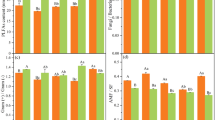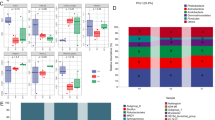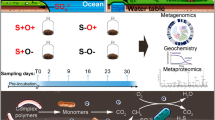Abstract
Global plant sulphur (S) deficiency is increasing because of a reduction in sulphate-based fertiliser application combined with continuous S withdrawal during harvest. Here, we applied 13C, 15N, 14C, and 35S quad labelling of the S-containing amino acids cysteine (Cys) and methionine (Met) to understand S cycling and microbial S transformations in the soil. The soil microorganisms absorbed the applied Cys and Met within minutes and released SO42− within hours. The SO42− was reutilised by the MB within days. The initial microbial utilisation and SO42− release were determined by amino acid structure. Met released 2.5-fold less SO42− than Cys. The microbial biomass retained comparatively more C and S from Met than Cys. The microorganisms decomposed Cys to pyruvate and H2S whereas they converted Met to α-ketobutyrate and S-CH3. The microbial stoichiometries of C, N, and S derived from Cys and Met were balanced after 4 d by Cys-derived SO42− uptake and Met-derived CO2 release. The microbial C:N:S ratio dynamics showed rapid C utilisation and loss, stable N levels, and S accumulation. Thus, short-term organic S utilisation by soil microorganisms is determined by amino acid structure whilst long-term organic S utilisation by soil microorganisms is determined by microbially controlled stoichiometry.
Similar content being viewed by others
Login or create a free account to read this content
Gain free access to this article, as well as selected content from this journal and more on nature.com
or
References
Dong Y, Silbermann M, Speiser A, Forieri I, Linster E, Poschet G, et al. Sulfur availability regulates plant growth via glucose-TOR signaling. Nat Commun. 2017;8:1174.
Freney JR, Melville GE, Williams CH. Soil organic matter fractions as sources of plant-available sulphur. Soil Biol Biochem. 1975;7:217–21.
Kopittke PM, Dalal RC, Finn D, Menzies NW. Global changes in soil stocks of carbon, nitrogen, phosphorus, and sulphur as influenced by long‐term agricultural production. Global Change Biol. 2017;23:2509–19.
Ciaffi M, Paolacci AR, Celletti S, Catarcione G, Kopriva S, Astolfi S. Transcriptional and physiological changes in the S assimilation pathway due to single or combined S and Fe deprivation in durum wheat (Triticum durum L.) seedlings. J Exp Bot. 2013;64:1663.
Ma Q, Luo Y, Wen Y, Hill PW, Chadwick DR, Wu L, et al. Carbon and sulphur tracing from soil organic sulphur in plants and soil microorganisms. Soil Biol Biochem. 2020;150:107971.
Piotrowska-Długosz A, Siwik-Ziomek A, Długosz J, Gozdowski D. Spatio-temporal variability of soil sulfur content and arylsulfatase activity at a conventionally managed arable field. Geoderma. 2017;295:107–18.
Fitzgerald JW, Watwood ME. Amino-acid metabolism in forest soil—Isolation and turnover of organic matter covalently labelled with 35S-methionine. Soil Biol Biochem. 1988;20:833–8.
Ma Q, Wen Y, Pan W, Macdonald A, Hill PW, Chadwick DR, et al. Soil carbon, nitrogen, and sulphur status affects the metabolism of organic S but not its uptake by microorganisms. Soil Biol Biochem. 2020;149:107943.
Jan MT, Roberts P, Tonheim SK, Jones DL. Protein breakdown represents a major bottleneck in nitrogen cycling in grassland soils. Soil Biol Biochem. 2009;41:2272–82.
Farrell M, Macdonald LM, Hill PW, Wanniarachchi SD, Farrar J, Bardgett RD, et al. Amino acid dynamics across a grassland altitudinal gradient. Soil Biol Biochem. 2014;76:179–82.
Wilkinson A, Hill PW, Farrar JF, Jones DL, Bardgett RD. Rapid microbial uptake and mineralization of amino acids and peptides along a grassland productivity gradient. Soil Biol Biochem. 2014;72:75–83.
Hill PW, Jones DL. Plant–microbe competition: does injection of isotopes of C and N into the rhizosphere effectively characterise plant use of soil N? N Phytol. 2018;221:796–806.
Godwin CM, Cotner JB. Aquatic heterotrophic bacteria have highly flexible phosphorus content and biomass stoichiometry. ISME J. 2015;9:2324–27.
Hartman WH, Ye R, Horwath WR, Tringe SG. A genomic perspective on stoichiometric regulation of soil carbon cycling. ISME J. 2017;11:2652–65.
Manzoni S, Jackson RB, Trofymow JA, Porporato A. The global stoichiometry of litter nitrogen mineralization. Science. 2008;321:684–6.
Cui J, Zhu Z, Xu X, Liu S, Jones DL, Kuzyakov Y, et al. Carbon and nitrogen recycling from microbial necromass to cope with C:N stoichiometric imbalance by priming. Soil Biol Biochem. 2020;142:107720.
Wei X, Zhu Z, Liu Y, Luo Y, Deng Y, Xu X, et al. C:N:P stoichiometry regulates soil organic carbon mineralization and concomitant shifts in microbial community composition in paddy soil. Biol Fert Soils. 2020;56:1093–107.
Maria M, Wolfgang W, Sophie ZB, Andreas R. Stoichiometric imbalances between terrestrial decomposer communities and their resources: mechanisms and implications of microbial adaptations to their resources. Front Microbiol. 2014;5:22.
Qiao N, Xu XL, Hu YH, et al. Carbon and nitrogen additions induce distinct priming effects along an organic-matter decay continuum. Sci Rep-UK. 2016;6:19865.
Kirkby CA, Kirkegaard JA, Richardson AE, Wade LJ, Blanchard C, Batten G. Stable soil organic matter: a comparison of C:N:P:S ratios in Australian and other world soils. Geoderma. 2011;163:197–208.
Manzoni S, Čapek P, Mooshammer M, Lindahl BD, Richter A, Šantrůčková H. Optimal metabolic regulation along resource stoichiometry gradients. Ecol Lett. 2017;20:1182–91.
Mooshammer M, Wanek W, Hämmerle I, Fuchslueger L, Hofhansl F, Knoltsch A, et al. Adjustment of microbial nitrogen use efficiency to carbon:nitrogen imbalances regulates soil nitrogen cycling. Nat Commun. 2014;5:3694.
Delgado-Baquerizo M, Reich PB, Khachane AN, Campbell CD, Thomas N, Freitag TE, et al. It is elemental: soil nutrient stoichiometry drives bacterial diversity. Environ Microbiol. 2017;19:1176–88.
Mayor JR, Mack MC, Schuur EAG. Decoupled stoichiometric, isotopic, and fungal responses of an ectomycorrhizal black spruce forest to nitrogen and phosphorus additions. Soil Biol Biochem. 2015;88:247–56.
Mooshammer M, Hofhansl F, Frank AH, Wanek W, Hämmerle I, Leitner S, et al. Decoupling of microbial carbon, nitrogen, and phosphorus cycling in response to extreme temperature events. Sci Adv. 2017;3:e1602781.
Chen J, Seven J, Zilla T, Dippold MA, Blagodatskaya E, Kuzyakov Y. Microbial C:N:P stoichiometry and turnover depend on nutrients availability in soil: A 14C, 15N and 33P triple labelling study. Soil Biol Biochem. 2019;131:206–16.
Ma Q, Wu L, Wang J, Ma J, Zheng N, Hill PW, et al. Fertilizer regime changes the competitive uptake of organic nitrogen by wheat and soil microorganisms: An in-situ uptake test using 13C, 15N labelling, and 13C-PLFA analysis. Soil Biol Biochem. 2018;125:319–27.
Jiang G, Zhang W, Xu M, Kuzyakov Y, Zhang X, Wang J, et al. Manure and Mineral Fertilizer Effects on Crop Yield and Soil Carbon Sequestration: a Meta‐Analysis and Modeling Across China. Glob Biogeochem Cy. 2018;32:1659–72.
Liu S, Wang J, Pu S, Blagodatskaya E, Kuzyakov Y, Razavi BS. Impact of manure on soil biochemical properties: a global synthesis. Sci Total Environ. 2020;745:141003.
Cheng L, Zhang N, Yuan M, Xiao J, Qin Y, Deng Y, et al. Warming enhances old organic carbon decomposition through altering functional microbial communities. ISME J. 2017;11:1825–35.
Ma Q, Wen Y, Wang D, Sun X, Hill PW, Macdonald A, et al. Farmyard manure applications stimulate soil carbon and nitrogen cycling by boosting microbial biomass rather than changing its community composition. Soil Biol Biochem. 2020;144:107760.
Ma Q, Wen Y, Ma J, Macdonald A, Hill PW, Chadwick DR, et al. Long-term farmyard manure application affects soil organic phosphorus cycling: a combined metagenomic and 33P/14C labelling study. Soil Biol Biochem. 2020;149:107959.
Jones DL, Hill PW, Smith AR, Farrell M, Ge T, Banning NC, et al. Role of substrate supply on microbial carbon use efficiency and its role in interpreting soil microbial community-level physiological profiles (CLPP). Soil Biol Biochem. 2018;123:1–6.
Jones DL, Magthab EA, Gleeson DB, Hill PW, Sánchez-Rodríguez AR, Roberts P, et al. Microbial competition for nitrogen and carbon is as intense in the subsoil as in the topsoil. Soil Biol Biochem. 2018;117:72–82.
Mariano E, Jones DL, Hill PW, Trivelin PCO. Mineralisation and sorption of dissolved organic nitrogen compounds in litter and soil from sugarcane fields. Soil Biol Biochem. 2016;103:522–32.
Corre M, Brumme R, Veldkamp EF. Changes in nitrogen cycling and retention processes in soils under spruce forests along a nitrogen enrichment gradient in Germany. Glob Change Biol. 2010;13:1509–27.
Spohn M, Kuzyakov Y. Phosphorus mineralization can be driven by microbial need for carbon. Soil Biol Biochem. 2013;61:69–75.
Wu J, Joergensen RG, Pommerening B, Chaussod R, Brookes PC. Measurement of soil microbial biomass C by fumigation-extraction—an automated procedure. Soil Biol Biochem. 1990;22:1167–9.
Glanville H, Hill PW, Schnepf A, Oburger E, Jones DL. Combined use of empirical data and mathematical modelling to better estimate the microbial turnover of isotopically labelled carbon substrates in soil. Soil Biol Biochem. 2015;94:154–68.
Greenfield LM, Hill PW, Paterson E, Baggs EM, Jones DL. Methodological bias associated with soluble protein recovery from soil. Sci Rep-UK. 2018;8:11186.
Näsholm T, Kielland K, Ganeteg U. Uptake of organic nitrogen by plants. N Phytol. 2010;182:31–48.
Farrell M, Prendergast-Miller M, Jones DL, Hill PW, Condron LM. Soil microbial organic nitrogen uptake is regulated by carbon availability. Soil Biol Biochem. 2014;77:261–7.
Niknahad-Gharmakher H, Piutti S, Machet JM, Benizri E, Recous S. Mineralization-immobilization of sulphur in a soil during decomposition of plant residues of varied chemical composition and S content. Plant Soil. 2012;360:391–404.
Vong PC, Piutti S, Slezackdeschaumes S, Benizri E, Guckert A. Effects of low-molecular-weight organic compounds on sulphur immobilization and re-mineralization and extraction of immobilized sulphur by hot-water and acid hydrolysis. Eur J Soil Sci. 2010;61:287–97.
Takriti M, Wild B, Schnecker J, Mooshammer M, Knoltsch A, Lashchinskiy N, et al. Soil organic matter quality exerts a stronger control than stoichiometry on microbial substrate use efficiency along a latitudinal transect. Soil Biol Biochem. 2018;121:212–20.
Zhu Z, Ge T, Luo Y, Liu S, Xu X, Tong C, et al. Microbial stoichiometric flexibility regulates rice straw mineralization and its priming effect in paddy soil. Soil Biol Biochem. 2018;121:67–76.
Xu X, Hui D, King AW, Song X, Thornton PE, Zhang L. Convergence of microbial assimilations of soil carbon, nitrogen, phosphorus and sulfur in terrestrial ecosystems. Sci Rep-UK. 2015;5:17445.
Fanin N, Fromin N, Buatois B, Ttenschwiler SH. An experimental test of the hypothesis of non-homeostatic consumer stoichiometry in a plant litter-microbe system. Ecol Lett. 2013;16:764–72.
Peters MK, Hemp A, Appelhans T, Becker JN, Behler C, Classen A, et al. Climate–land-use interactions shape tropical mountain biodiversity and ecosystem functions. Nature. 2019;568:88–92.
Kaiser C, Franklin O, Dieckmann U, Richter A. Microbial community dynamics alleviate stoichiometric constraints during litter decay. Ecol Lett. 2014;17:680–90.
Xu X, Schimel JP, Thornton PE, Song X, Yuan F, Goswami S. Substrate and environmental controls on microbial assimilation of soil organic carbon: a framework for Earth system models. Ecol Lett. 2014;17:547–55.
Apostel C, Dippold M, Kuzyakov Y. Biochemistry of hexose and pentose transformations in soil analyzed by position-specific labeling and 13C-PLFA. Soil Biol Biochem. 2015;80:199–208.
Manzoni S, Taylor P, Richter A, Porporato A, Ågren GI. Environmental and stoichiometric controls on microbial carbon‐use efficiency in soils. N Phytol. 2012;196:79–91.
Fitzgerald JW, Hale DD, Swank WT. Sulphur-containing amino acid metabolism in surface horizons of a hardwood forest. Soil Biol Biochem. 1988;20:825–31.
Akashi H, Gojobori T. Metabolic efficiency and amino acid composition in the proteomes of Escherichia coli and Bacillus subtilis. P Natl Acad Sci USA. 2002;99:3695–700.
Nozaki T, Ali V, Tokoro M. Sulfur-Containing Amino Acid Metabolism in Parasitic Protozoa. Adv Parasit. 2005;60:1–99.
Takagi H, Ohtsu I. l-Cysteine Metabolism and Fermentation in Microorganisms. Adv Biochem Eng Biotechnol. 2016;159:129–51.
Bustos I, Miguel AM, Fouad A, Carmen P, Teresa R, CM M. Volatile sulphur compounds-forming abilities of lactic acid bacteria: C-S lyase activities. Int J Food Microbiol. 2011;148:121–7.
Assefa MK, Tucher SV, Schmidhalter U. Soil sulfur availability due to mineralization: soil amended with biogas residues. J Soil Sci Enviro Manag. 2014;5:13–9.
Acknowledgements
This work was supported by the National Key Research and Development Program of China (SQ2020YFD10006-02), the National Natural Science Foundation of China (Nos. 31872180 and 31801936), the UK-China Virtual Joint Centre for Agricultural Nitrogen (CINAg. No. BB/N013468/1), and the Newton Fund via UK BBSRC, NERC, and the Chinese Ministry of Science and Technology. The Rothamsted Long-Term Experiments National Capability (LTE-NCG) was supported by the UK Biotechnology and Biological Science Research Council (No. BBS/E/C/000J0300) and the Lawes Agricultural Trust. The authors thank the curators of the Electronic Rothamsted Archive (e-RA) for access to data from the Rothamsted Long-Term Experiments. The authors also thank Mr Steve Freeman for his assistance with sample collection. YK recognises the Government Program of Competitive Growth of Kazan Federal University and the “RUDN University Program 5-100” for their support.
Author information
Authors and Affiliations
Corresponding author
Ethics declarations
Competing interests
The authors declare no competing interests.
Additional information
Publisher’s note Springer Nature remains neutral with regard to jurisdictional claims in published maps and institutional affiliations.
Supplementary information
Rights and permissions
About this article
Cite this article
Ma, Q., Kuzyakov, Y., Pan, W. et al. Substrate control of sulphur utilisation and microbial stoichiometry in soil: Results of 13C, 15N, 14C, and 35S quad labelling. ISME J 15, 3148–3158 (2021). https://doi.org/10.1038/s41396-021-00999-7
Received:
Revised:
Accepted:
Published:
Issue Date:
DOI: https://doi.org/10.1038/s41396-021-00999-7
This article is cited by
-
Impacts of Spartina alterniflora invasion on C-cycling functional genes and microbial communities in salt marsh wetlands during cold season
Ecological Processes (2025)
-
Enzymatic Stoichiometry and Vector Characteristics Can Indicate Microbial Resource Limitation: Empirical Evidence from Experiment with Multiple Nutrient Addition
Ecosystems (2025)
-
Effect of elements availability on the decomposition and utilization of S-containing amino acids by microorganisms in soil and soil solutions
Plant and Soil (2025)
-
Biodegradation and bioavailability of low-molecular-weight dissolved organic sulphur in soil and its role in plant-microbial S cycling
Plant and Soil (2024)
-
Utilisation and transformation of organic and inorganic nitrogen by soil microorganisms and its regulation by excessive carbon and nitrogen availability
Biology and Fertility of Soils (2023)



